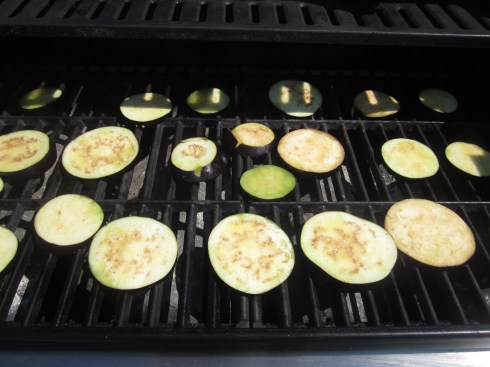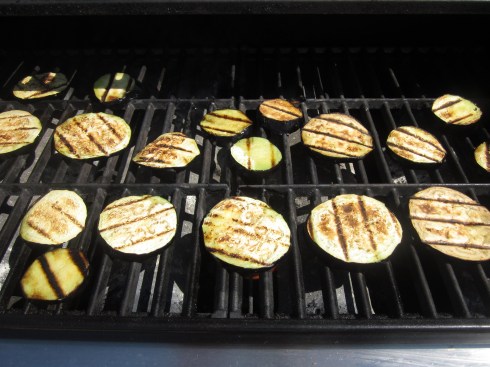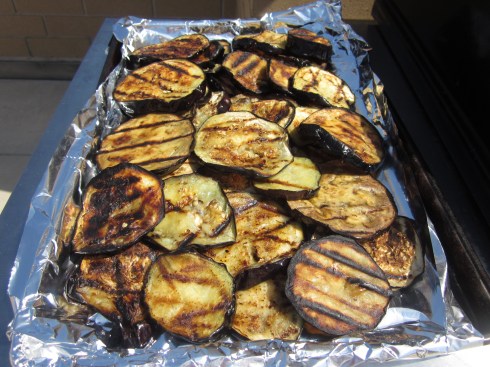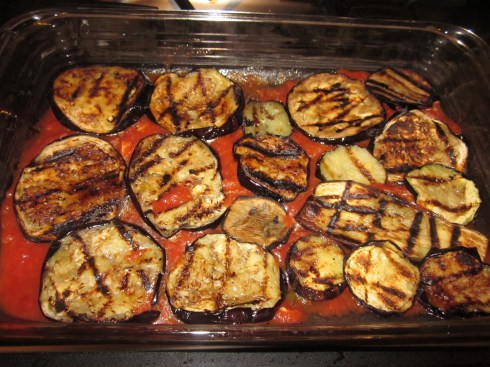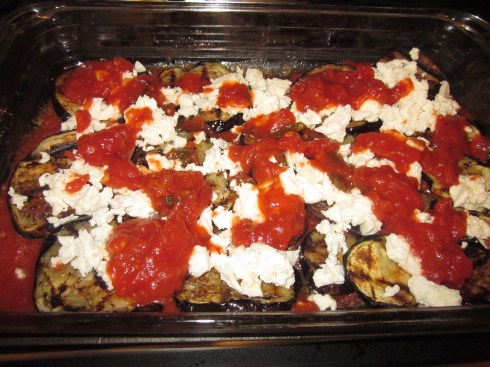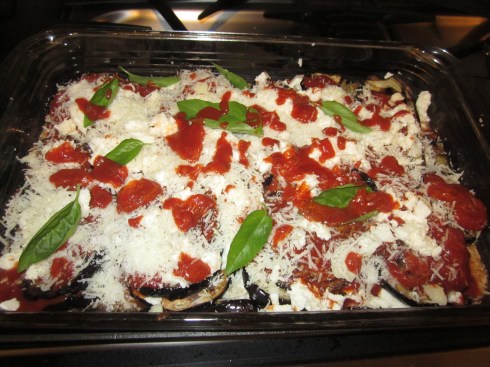
I heard tell there was a big wind coming our way. A super storm they were calling it. The terrace had to be cleared of potentially dangerous projectiles. The few herbs that remained were not a threat, but the never ending procession of hot peppers that were still going strong in late October had to be “terminated with extreme prejudice.”
In May I planted two types of hot peppers I bought in the Arthur Avenue Retail market in the Bronx including one I’ve grown before called “Portugal Hots,” a long thin pepper similar to the cayenne. The other was labeled an “Italian chili pepper.” I wasn’t sure what an “Italian chili pepper” was but hoped that it was similar to what was sold in the same retail market in the fall; bunches of slender, one-inch long red, fiery chilies still attached to their stalks. I was assured by the salesperson that it was.
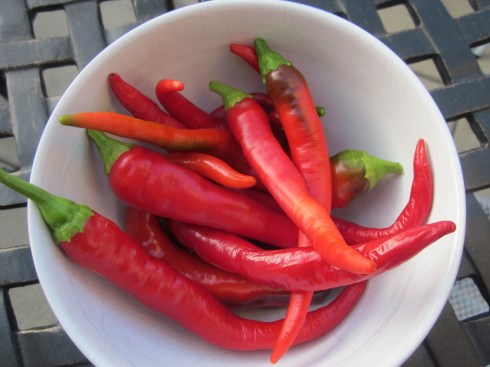
Portugal Hots
In the abnormally warm spring and hot summer, the plants grew fast and when the first fruits began to appear, I was surprised by what I saw on the so-called Italian chili pepper plant. The peppers were growing upright and looked something like jalapeno peppers. Once they were green and fully formed, they were definitely not the Italian red chili peppers I had hoped for.
I scoured the internet to find a match to what I was growing. What I discovered was that the peppers were called “Fresno” and, according to my research, similar to a jalapeno. I was disappointed. I didn’t want a jalapeno or anything “similar.” The plants were healthy and the numbers of peppers on them countless. When the first pepper turned red, I tried it. It had very little heat adding to my disappointment.
A few weeks later, as more turned red, I cut up another. This time I was blasted by heat. And as the summer wore on and the peppers matured further, their fire became explosive—much hotter than a jalapeno, Serrano, and spicier than the Portugal hots that were growing next to them. I had some serious hotties on my hand. If the Scoville scale that is my tongue was any indication, these Fresnos were just a notch behind the habanero in heat quotient.
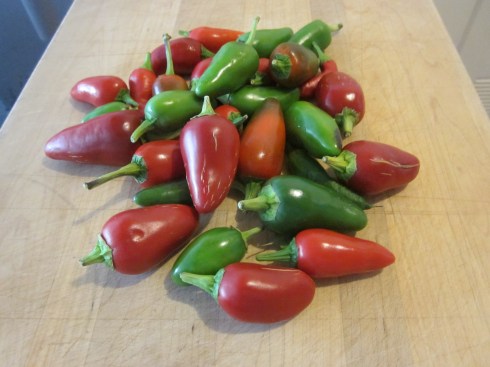
Fresno peppers
As both the Portugal hots and the Fresnos prospered throughout the summer and into early fall, I bagged bunches and put them in the freezer where they would last a year. Frozen, I use them in stews, sauces and anything else that required a blast of spice. I had more than enough already to last a year so I gave bags away to others who, like me, get masochistic enjoyment when the inside of their mouths are blistered.
Still, many peppers kept coming as summer faded and though some were still green, a super storm was on its way and I had no alternative but to harvest what remained.
As any self respecting citizen should, I have several bottles of hot pepper sauce in my refrigerator ranging from mild to hiccup-inducing hot. Is there such a thing as having too much hot sauce? I didn’t think so. So inspired by a fellow bloggers at website caled Putney Farm who had a similar dilemma and turned that profusion of peppers into a homemade pepper sauce, I thought I would try it as well. But because I had two different types of peppers, I decided to make two different pepper sauces.
As I do with many recipes, I cull the internet and usually mix and match from a variety I like and try to come up with something my own. The first, using the Portugal hots, was to be a “fermented” pepper sauce or one I would have steep in a brine for several days before actually pureeing into a sauce.
Since I just used what I had of peppers, the quantities of the ingredients I pretty much played by ear. For the fermented hot pepper sauce, I had enough of the Portugal hots, (green stems removed) to fill up a pint jar.
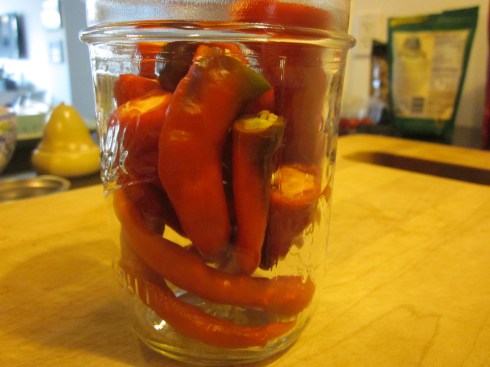
To the jar I added three peeled whole garlic cloves and two teaspoons of sea salt.
I then filled the jar with water and made sure the peppers and the garlic were submerged before tightening the lid of the jar.

Once the jar was sealed, I placed it in the back of a dark cabinet and let it ferment for about 10 days. You can ferment, from what I gathered, for as little as a few days up to two weeks. I was in no rush.
After ten days, I opened the jar and drained off the water (now a brine), saving it to add back into the sauce. I put the garlic and the peppers into a blender and added back half of the brine along with an equal amount of white vinegar. Depending on how you like your hot sauce; chunky or smooth, is how long you puree. I wanted mine closer to smooth than chunky so I pureed long enough to get that consistency.
After pureeing, I poured the hot sauce back into the pint jar, sealed it, and put it in the refrigerator. The sauce will last a year—or until you are ready to make another batch next year.
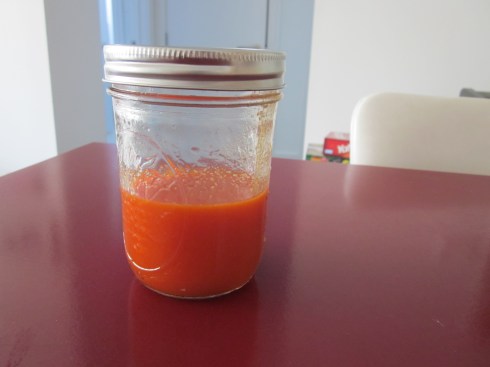
Portugal Hot pepper sauce pureed smooth.
The recipe for the Fresno hot sauce was pretty much identical to what my friends at Putney Farms laid out in their blog post Homemade Hot Sauce. In theirs, they used Serrano peppers. The Fresnos I grew, as I said, were hotter than Serranos, but I didn’t think that would necessitate a change in the recipe.
Their recipe called for 8 ounces of peppers. I had more and adjusted accordingly. Not using rubber gloves, I sliced all the Fresno peppers, but made sure I kept my hands away from my eyes, nose, and private parts until I could sufficiently wash them.
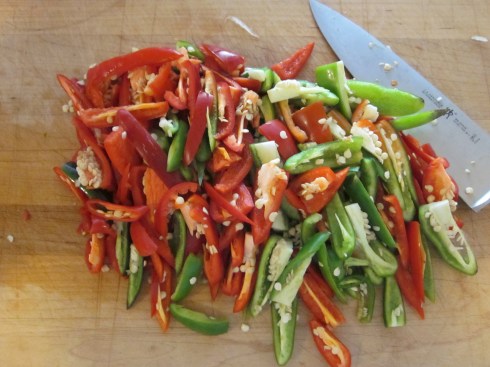
Along with the peppers I sliced one large white onion and minced two garlic cloves.
To a medium saucepan, I put a tablespoon of olive oil. And then, on medium heat, added the peppers, onions and garlic. The recipe at Putney Farms warns of the fiery vapors that will be unleashed from the sautéing of the peppers. It was in the forties outside, yet I opened the windows, turned on the ceiling fan, and commenced the sautéing. For extra protection I wore a surgical mask. After a few minutes, however, I removed it. The vapors were helping to clear congestion in my chest. Just another one of the magical benefits of the revered and cherished capsicum.
After sautéing for about five minutes, I added two cups of water and two tablespoons of brown Demerara sugar. I cooked all for about twenty minutes or until most of the water was evaporated.
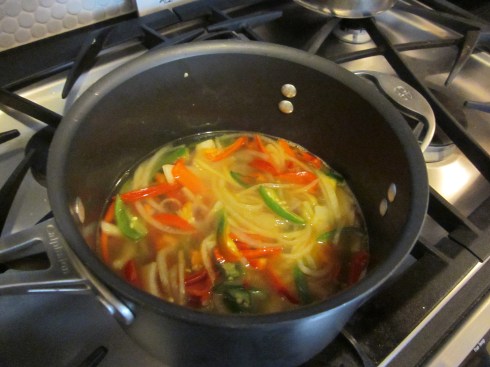
Once the mix of peppers, onions and garlic cooled to room temperature, I added a cup of cider vinegar and pureed in a blender.
I poured the puree through a fine mesh sieve until only the thick skins and seeds still remained and what passed through was a smooth, creamy, pinkish mixture.

Now I had two hot sauces. I tried them both.
The Portugal hot fermented sauce had a mild pepper kick. The Portugal hots, I’ve found, can be inconsistent in terms of heat. Some are very hot while there might be a few that have barely a trace of fire. Knowing that, I still like them for their intensely sweet pepper flavor that when combined with the heat makes a unique taste. The sauce, however, though with a slight, vinegary tang, was overpowered by garlic. I would definitely limit the garlic if I decided to make the sauce again. Still, I looked forward to sprinkling a generous amount over roast chicken with yellow rice and beans.

Portual hots hot sauce
The Fresno pepper sauce on the other hand was everything I wanted. Just a few drops would suffice on any dish, it was that hot. There was also a sweetness from the inclusion of brown sugar and cider vinegar that added to the flavor. If anything, I would cut down on the sugar a bit next time.

Fresno hot sauce
Tags: cooking, culture, Dining, Food, humor, New York City, Recipes

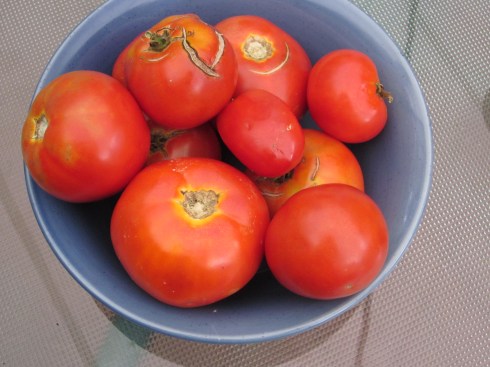

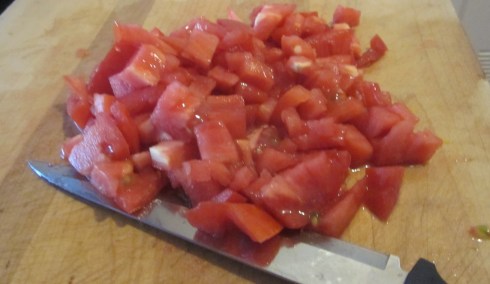






 On their website,Time asked: “Start Hoarding Now: A Global Bacon Shortage Is Coming?” This of course, sent thousands, no millions into panic and premature grief over the possibility of converting to turkey bacon.
On their website,Time asked: “Start Hoarding Now: A Global Bacon Shortage Is Coming?” This of course, sent thousands, no millions into panic and premature grief over the possibility of converting to turkey bacon.











